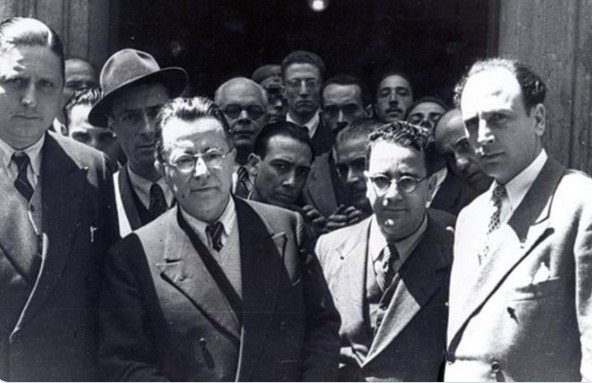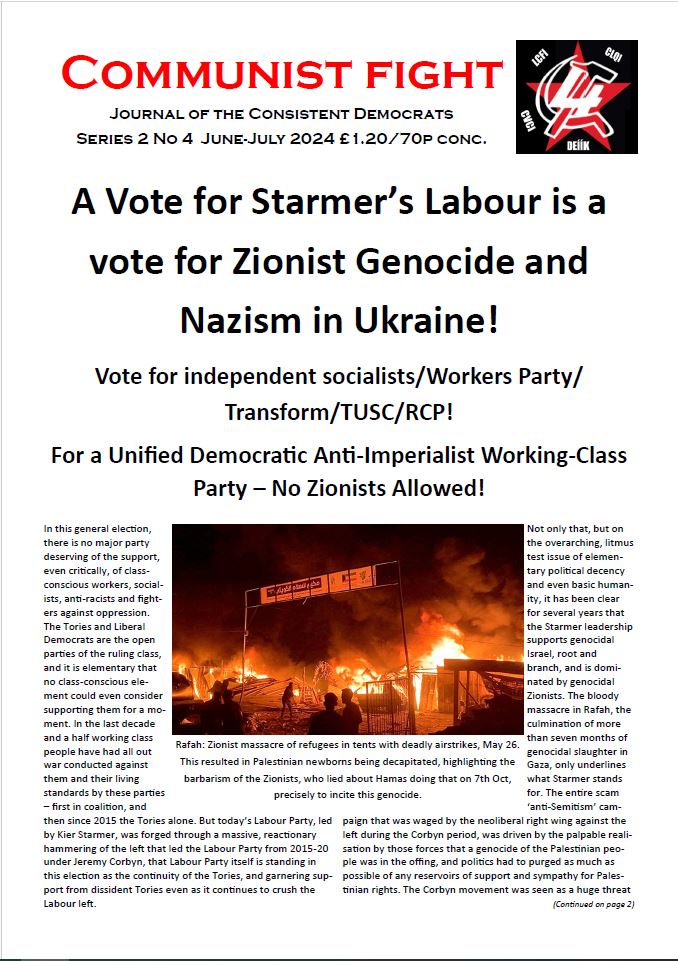By Humberto Rodrigues and Christian Romero

Popular fronts are fronts between workers’ parties and parties of capital. They can be divided into 3 categories and even more than 3 as we will see later. Lula’s Broad Front with Alckmin is a more bourgeois expression of the traditional popular front.
The Communist League supports Lula’s candidacy as the only instrument to defeat the fascist Bolsonaro at this time and on the ground of bourgeois elections but criticizes the broad front as a trap of class reconciliation with the bourgeoisie and the golpismo that can cause us serious future problems.
The popular fronts were born as a theoretical formulation after a 180° turn in the tactics of the 3rd International, then under the control of Stalinism. Until the adoption of this tactic, almost in the mid-1930s, the political orientation for CPs was to avoid alliances with social democracy against fascism.
Despite the strength of the USSR and the size and influence of the mass support for communist parties and social democracy, such a sectarian tactic allowed the conversion of Nazism from marginal force to mass party and Hitler’s rise in Germany in 1933.
Georgi Dimitrov, then secretary general of the Communist International, communicates the new policy in a May 1934 Pravda article, which went on to comment favorably on socialist-communist collaboration. The reorientation was formalized at the VII Congress of the Communist International in July 1935 and reached its apotheosis with the proclamation of a new policy: “Popular Front Against Fascism and War”.
Since then, Communist Parties have been instructed to form broad alliances with all “anti-fascist parties”, not only parties of working-class origin, such as social democrats and labour, but also bourgeois parties, with the aim of ensuring social advancement in the conjunctural internal struggle of countries.
Less than a decade later, Stalinism was forced to do the same zig-zag, to extend this nationally waged politics, also to the military and international level against Nazism.
A Worldwide Popular Front
At the international level, the change in orientation of Stalinism also underwent a 180° turn, only later. Although since 1934 there has been official guidance for CPs to build the “Popular Front Against Fascism and War”, on August 23, 1939, the governments of Stalin and Hitler signed the Treaty of Non-Aggression between Germany and the Union of Soviet Socialist Republics (USSR), known mainly as the Molotov–Ribbentrop pact, due to the names of the German and Soviet Foreign Ministers, Joachim von Ribbentrop and Viatcheslav Molotov, respectively. This pact was followed by the German-Soviet Trade Agreement in February 1940. The pact lasted until June 22, 1941, when Germany, without notice, began the invasion of Soviet territory in Operation Barbarossa.
Just as after Hitler’s rise in Germany, after the massive invasion of the USSR by the Nazi army, surprising Stalin, who had believed in the treaty of non-aggression, Stalinism also performed a turn in its international front policy and created an alliance with the Anglo-Saxon imperialist countries against the former Nazi ally. At that time, the USSR’s alliance with the Anglo-Saxon imperialist countries, which in the previous decade set up Nazism against the USSR, may have been the first worldwide popular front.
This worldwide popular front with the Western big capital resulted in the extinction of the 3rd International (which was created by Lenin in 1919) in the middle of World War II! The Communist International was extinguished on May 15, 1943. In 1949, imperialism created its international anti-USSR, NATO. With this front with the USSR, imperialism also managed to establish a policy of containment of the European revolution, at a very favorable time due to the almost lack of regimes and bourgeois states after the war and when anti-fascist resistance sprees animated by the Communists defeated the Nazi-fascist occupation in several nations. Imperialism has fueled this restraint with the counterrevolutionary agreements of Yalta and Potsdan, of dividing the area of influence with imperialism, which smothered revolutions such as in Greece, Italy, etc.
From the historical experience of the development of popular fronts at the national level, we evaluate three perspectives for the development of the popular front tactic:
1) FASCISM: The popular front in its most classical conception can give way to fascism as it did in France, Spain in the 1930s, or chile in the 1970s. After frustrating the expectations of its social bases, aborting the possibilities of social revolution, disarming political and militarily the organizations of the proletariat, the popular front leaves the way clear for the triumph of fascism.
2) BROAD LIQUIDATION FRONT: The popular fronts can constitute broad fronts where they progressively dissolve in the capitalist state machine until they completely disintegrate. An example of this we have in the Italian Communist Party, the largest communist party in the entire West.
In the process of this liquidating degeneration of the broad front, the PCI justified its strategy with so-called Eurocommunism. Under the guidance of Togliatti, with the fall of Mussolini in Italy, already in April 1944 was proclaimed the “turning point of Salerno”, a commitment to the traditional bourgeois parties giving rise to a government of national-bourgeois unity.

From that immense communist movement, very little is left and after decades of liquidationism, neofascism emerged with force in Italy in 2022. This broad-fronted policy has been responsible for the demoralization and dissolution of left-wing organizations in all the countries in which it is applied, as in Chile after the Pinochet dictatorship and in Uruguay, with the Broad Front.
It should not be ruled out that in the short or medium term, this second demoralizing variable of alliances with the class enemy does not result in the triumphant return of fascism or neofascism, which in Brazil is represented today by Bolsonarism.
3) SINGLE ANTI-IMPERIALIST FRONT (FUA): Uniquely popular fronts can evolve into Anti-Imperialist Fronts. As considered in the Fourth International’s Transitional Programme:
It is, however, impossible to categorically and in advance deny the theoretical possibility that, under the influence of a combination of exceptional circumstances (war, defeat, financial breakdown, revolutionary offensive of the masses, etc.), the small-bourgeois parties, including stalinists there, can go further than they wanted on the road to rupture with the bourgeoisie.
Transitional Programme
This possibility is not ruled out and under exceptional historical determinations the popular front was broken by capitalist or imperialist allies, advanced the expropriation of imperialism and permanently from capital as in the Yugoslav, Chinese, Cuban and Vietnamese revolutions. However, these experiences did not create Soviet-type governments, supported by popular councils, as in the early years of the Bolshevik government.
In these circumstances, deformed workers states were created, most often the anti-imperialist fronts develop as political revolutions not advancing in the expropriation of the bourgeoisie as a class, not advancing in the social dimension, or at most advancing partially and with time receding in the face of the reaction that is strengthened and returns.
Examples of this latter variant can be noted with different singularities in Iran and Nicaragua in 1979, Burkina Faso in the 1980s, especially after the beginning of the imperialist offensive of financialization, dismantling western industrialization processes. Perhaps you can also put in this category Angola, Mozambique and South Yemen. The set of these revolutionary processes and their lessons need to be studied on a case-by-case basis.
A Single Anti-Imperialist Front Worldwide
At the international level, imperialist decay in its financialisation phase (1970-2022), marked by deindustrialisation, trade war and sanctions against oppressed peoples and workers’ states, caused, after the financial crisis of 2008-2010, the breakdown of the capitalist balance in the struggle between nations.
China, industrialized through global labor arbitrage (John Smith) by imperialism itself, has made the capitalist world dependent on its production chain, both in the import and export of goods, designed to become the nation holding the largest Gross Domestic Product since the 2008 crisis.
To try to contain Chinese influence derived from China’s conquest of world markets, the U.S. sought to strike through mechanisms of hybrid warfare, lawfare, parliamentary and military coups with governments that have approached China politically. This is what happened with Honduras, Libya, Paraguay, Ecuador, Ukraine, Brazil, Bolivia…
Russia, after suffering a decade of Pinochetist shock doctrine, a speculative attack in 1998 and NATO’s military expansion to the East after the end of the USSR (1991), seeks to defend itself by renationalizing part of the economy and disputing political, military and indirectly the former areas of influence of the USSR with imperialism.
From then on, China and Russia were forced to establish a defensive alliance against the onslaught of the U.S. and its NATO allies, and AUKUS in the Pacific, a strategic alliance supported by the dialectics of a new Cold War, stronger than the political ties that Stalinist bureaucracies possessed and which were easily disrupted by the imperialist harassment that threw China against Russia in the 1970s.
This alliance, also made up of other oppressed nations such as Venezuela, Iran, Nicaragua, Syria, and the workers’ states of Cuba and North Korea, is a single anti-imperialist front. The most advanced, proletarian and open-war fraction against imperialism of this AUF is in the People’s republics in the Donbass in eastern Ukraine. As NATO recreated Nazism in Ukraine for its Russophobe offensive, the anti-imperialist struggle in Ukraine was forced to turn into an anti-fascist struggle, so the current AUF is anti-imperialist and anti-fascist.
The hostility and pressure of imperialism are, by denial, a driving force of the anti-imperialist and socialist struggle, forging the “antagonistic cooperation” of the oppressed, historically forced non-revolutionary leaderships to lead revolutions, to go beyond where they desired in the line of rupture with the world system dominated by the US. If as Moniz Bandeira said, “empires are more dangerous when they decline”, at this time of decline of imperialism then this driving force is greater and more tensioning in favor of an opposing resistance.
Can the world proletariat triumph without taking advantage of the contradictions of the class enemy, the decay of imperialism, the breaking of the inter-State capitalist balance? With the Single Anti-Imperialist Front as a tactic, as a starting point, it must have the Permanent Revolution as a strategy, as a point of arrival. It cannot triumph without taking advantage of the dispute between financial capital and productive capital, to fight for reindustrialization, to expand the number of our class, which embodied by its greatest advantage, its number, to advance towards its own class strategy that goes far beyond the strategy of the governments of the nations that make up the AUF, to convert the fight against imperialism into an internationalist struggle, proletarian, revolutionary and permanent, for socialism.

